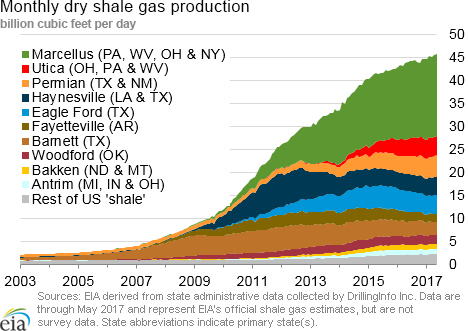Updated July 10, 2017 to clarify text.
In the News:
Qatar plans to increase liquefied natural gas (LNG) production capacity by 30% by 2024
On July 4, 2017, Qatar Petroleum (QP) announced plans to effectively end the moratorium on all new production projects that QP has had in place since 2005. In the announcement, QP signaled its intention to increase natural gas production from its North Field by 20% (1 million barrels of oil equivalent per day) over the next five to seven years. The additional volumes will come from new projects in the southern sector of the North Field. The extra natural gas production will be dedicated to the production and export of LNG and will involve a 30% increase in liquefaction capacity, from 10 billion cubic feet per day (Bcf/d) to 13 Bcf/d.
Qatar’s lifting of the moratorium on new production from the North Field comes at a time when Iran’s national oil company – National Iranian Oil Co. – continues development of its South Pars natural gas project. The North Field extends across Qatar’s maritime border with Iran, which calls its side of the field South Pars. As of 2015, proved natural gas reserves held in the North Field and the South Pars were estimated to total 872 trillion cubic feet (Tcf) and 480 Tcf, respectively. During 2016, Iran produced 19.5 Bcf/d of natural gas. By March 2018, Iran plans to increase natural gas production from its South Pars field by 5.3 Bcf/d day, bringing the total production to 24.8 Bcf/d. Qatari officials have emphasized that lifting the moratorium and the subsequent plans to increase production are not prompted by Iran’s plans to develop its part of the shared field.
Qatar has increased its LNG exports by 5.6% from 2011 to 2016 by running liquefaction trains above nameplate capacity. Over the years, several studies have explored engineering requirements for debottlenecking of existing liquefaction trains, which identified a potential increase in liquefaction capacity equivalent to 1.6 Bcf/d through debottlenecking. The May 31, 2017, agreement with Chiyoda Corporation marks the latest in this series of debottlenecking studies.. Recent trade sanctions imposed on Qatar by neighboring Arab countries introduce a measure of uncertainty in future exports. But so far, the sanctions have not noticeably reduced the level of LNG exports out of the country.
Overview:
(For the Week Ending Wednesday, July 5, 2017)
- Natural gas spot prices fell at most locations this report week (Wednesday, June 28 to Wednesday, July 5). The Henry Hub spot price fell from $3.01 per million British thermal units (MMBtu) last Wednesday to $2.90/MMBtu yesterday.
- At the New York Mercantile Exchange (Nymex), the July 2017 contract expired last Wednesday at $3.067/MMBtu. The August 2017 contract price decreased to $2.840/MMBtu yesterday, down 25¢ Wednesday to Wednesday.
- Net injections to working gas totaled 72 billion cubic feet (Bcf) for the week ending June 30, 2017. Working natural gas stocks reached 2,888 Bcf, 9% less than the year-ago level and 7% more than the five-year (2012–16) average for the week.
- The natural gas plant liquids composite price at Mont Belvieu, Texas, rose by 25¢, averaging $5.80/MMBtu for the week ending July 5. The price of natural gasoline, ethane, propane, butane, and isobutane all rose, by 6%, 2%, 4%, 7%, and 7%, respectively.
- According to Baker Hughes, for the week ending Friday, June 30, the natural gas rig count increased by 1 to 184. The number of oil-directed rigs fell by 2 to 756. The total rig count decreased by 1, and it now stands at 940.
Prices/Supply/Demand:
Spot prices mostly down outside of Southern California. This report week (Wednesday, June 28 to Wednesday, July 5), the Henry Hub spot price fell 11¢ from $3.01/MMBtu last Wednesday to $2.90/MMBtu yesterday. At the Chicago Citygate, prices decreased 9¢ over the report week to $2.75/MMBtu yesterday. Prices at PG&E Citygate in Northern California fell 4¢ to $3.15/MMBtu yesterday.
The price at SoCal Citygate increased 27¢ from $3.08/MMBtu last Wednesday to $3.35/MMBtu yesterday. The spot price at SoCal Citygate jumped yesterday as the hot weather increased air conditioning demand. Early this morning, the National Weather Service issued an Excessive Heat Warning for the region.
Northeast prices down sharply. At the Algonquin Citygate, which serves Boston-area consumers, prices went down 48¢ week over week to $2.23/MMBtu yesterday. At the Transcontinental Pipeline Zone 6 trading point for New York, prices decreased 33¢ to $2.23/MMBtu yesterday.
Marcellus price points remain persistently lower than the rest of the nation, mostly lower than $2.00/MMBtu. Tennessee Zone 4 Marcellus spot prices decreased 1¢ from last Wednesday to $1.91/MMBtu yesterday. Prices at Dominion South in northwest Pennsylvania rose 3¢ to $1.97/MMBtu yesterday.
Price of August contract falls; July contract expires. At the Nymex, the July 2017 contract expired last Wednesday at $3.067/MMBtu. The August 2017 contract decreased to $2.840/MMBtu, down 25¢ from last Wednesday to yesterday. The price of the 12-month strip, which averages August 2017 through July 2018 futures contracts, declined 19¢ to $2.925/MMBtu.
Supply up slightly. According to data from PointLogic, the average total supply of natural gas and dry natural gas production each rose by 1% compared with the previous week. Average net imports from Canada increased by 3% from last week.
Demand up slightly. Total U.S. consumption of natural gas rose by 1% compared with the previous report week, according to data from PointLogic. Power burn climbed by 7% week over week as the hot weather drove up demand for cooling. The increase in power burn more than offset a 20% decrease in demand in the residential and commercial sectors. Industrial sector consumption decreased by 1% week over week. Natural gas exports to Mexico decreased 4%.
U.S. LNG exports remain the unchanged week over week. Three vessels (combined LNG-carrying capacity of 10.8 Bcf) departed Sabine Pass last week (Thursday to Wednesday).
One of the U.S. LNG export projects, Freeport LNG, filed an application with the Federal Energy Regulatory Commission for authorization to construct the fourth train at the facility, which has a nameplate capacity of 0.67 Bcf/d and a target online date in 2022. Three other trains are currently under construction and are scheduled to come online “sequentially between Q4 2018 and Q3 2019,” according to a Freeport LNG announcement.
Last week, the U.S. Department of Energy authorized additional exports of 0.33 Bcf/d at the Lake Charles LNG Project in Lake Charles, Louisiana. The project is now authorized to export up to 2.33 Bcf/d of LNG.
Storage:
Weekly net injections exceed the five-year average. Net injections into storage totaled 72 Bcf for the week ending June 30, 2017 compared with the five-year (2012–16) average net injection of 66 Bcf and last year's net injections of 38 Bcf during the same week. For seven out of the last nine weeks, the weekly net injection has been smaller than the five-year average. The larger-than-average net injections this week likely resulted from the cooler-than-normal temperatures that prevailed throughout most of the Lower 48 states, which mitigated cooling demand for natural gas. Working gas stocks total 2,888 Bcf, which is 187 Bcf more than the five-year average and 285 Bcf less than last year at this time.
So far in the 2017 refill season, net injections into working gas storage are below the five-year average in most regions of the Lower 48 states. Net injections into working gas totaled 837 Bcf since March 31, 2017—the traditional beginning of the refill season—compared with the five-year average of 915 Bcf. Smaller-than-average net injections thus far during the 2017 injection likely reflect that storage levels are already above historical norms, combined with high electric sector demand as a result of warmer-than-normal spring temperatures on average and relatively high levels of natural gas exports. The East and Mountain regions stand out as the only regions where net injections have exceed the five-year average. Cumulative net injections during the refill season totaled 695 Bcf by this time in 2016, which also was characterized by unusually high storage levels at the start of the refill season, as is the case this year.
The January 2018 futures price is trading at a premium over the current spot price, but the premium is smaller than a year ago. During the most recent storage week, the average natural gas spot price at the Henry Hub was $2.97/MMBtu, while the Nymex futures price of natural gas for delivery in January 2018 averaged $3.36/MMBtu, a difference of 40¢. The premium for January 2017 was 58¢ one year ago. In comparison, the average natural gas spot price at the Henry Hub during the most recent storage week was $2.97/MMBtu, 5¢ lower than the August 2017 (front-month) futures price at the Nymex. A year ago, the spot price was 1¢ higher than the front-month contract.
Reported net implied flows into storage are near the upper end of the range of expectations. According to Bloomberg’s survey of natural gas analysts, estimates of net injections to working natural gas storage ranged from 57 Bcf to 73 Bcf with a median of 66 Bcf. Prices of the Nymex futures contracts for August 2017 delivery at Henry Hub fell 3¢ to $2.89/MMBtu in 1,076 trades at the release of the Weekly Natural Gas Storage Report (WNGSR). Prices varied in subsequent trading, ranging between $2.88/MMBtu and $2.90/MMBtu.
Lower-than-normal temperatures lead to larger-than-normal injections into storage. Temperatures in the Lower 48 states averaged 72 degrees Fahrenheit (°F), 1°F lower than the normal and 4°F lower than last year at this time. Temperatures in the South Central region- where natural gas-fired electricity generation for air conditioning plays a crucial role in summertime demand for natural gas were cooler than normal. Temperatures in the East South Central Census division averaged 74°F, 3°F lower than the normal and 7°F lower than last year at this time, while temperatures in the West South Central Census division averaged 80°F, 1°F lower than the normal and 4°F lower than last year.
See also:
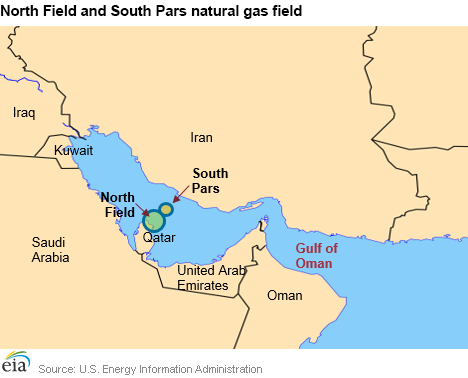
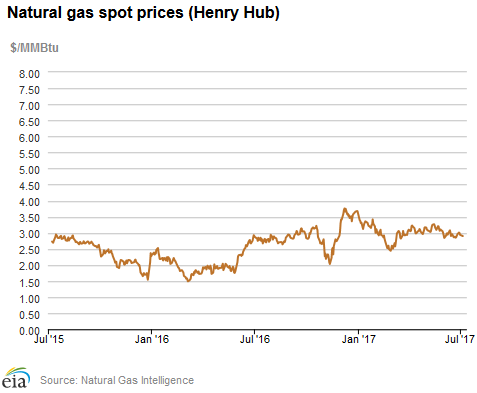
| Spot Prices ($/MMBtu) | Thu, 29-Jun |
Fri, 30-Jun |
Mon, 3-Jul |
Tue, 4-Jul |
Wed, 5-Jul |
|---|---|---|---|---|---|
| Henry Hub | 3.00 |
2.94 |
Closed |
Holiday |
2.90 |
| New York | 2.79 |
2.52 |
Closed |
Holiday |
2.23 |
| Chicago | 2.83 |
2.67 |
Closed |
Holiday |
2.76 |
| Cal. Comp. Avg.* | 2.84 |
2.68 |
Closed |
Holiday |
2.91 |
| Futures ($/MMBtu) | |||||
| August Contract | 3.042 |
3.035 |
Closed |
Holiday |
2.840 |
| September Contract | 3.037 |
3.031 |
Closed |
Holiday |
2.837 |
| *Avg. of NGI's reported prices for: Malin, PG&E Citygate, and Southern California Border Avg. | |||||
| Source: NGI's Daily Gas Price Index | |||||
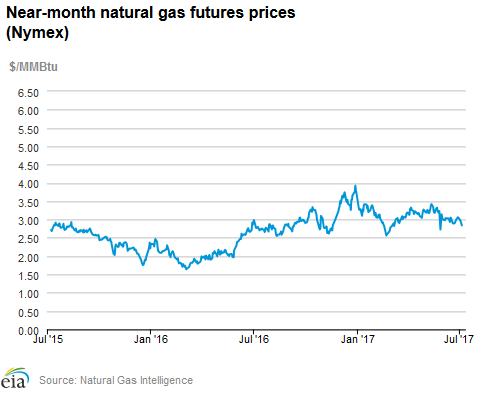
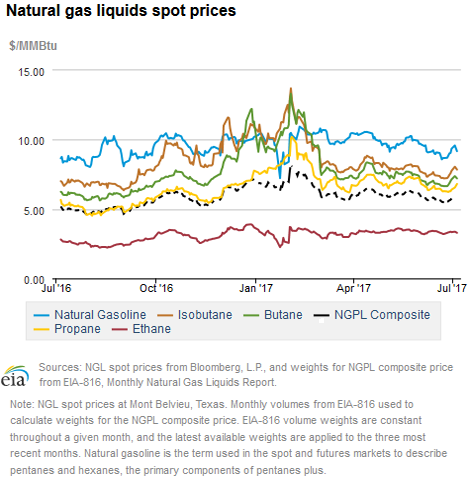
| U.S. natural gas supply - Gas Week: (6/29/17 - 7/5/17) | |||
|---|---|---|---|
Average daily values (Bcf/d): |
|||
this week |
last week |
last year |
|
| Marketed production | 81.5 |
80.7 |
80.0 |
| Dry production | 72.3 |
71.6 |
71.2 |
| Net Canada imports | 5.8 |
5.7 |
6.1 |
| LNG pipeline deliveries | 0.0 |
0.0 |
0.0 |
| Total supply | 78.1 |
77.3 |
77.3 |
|
Source: OPIS PointLogic Energy, an IHS Company | |||
| U.S. natural gas consumption - Gas Week: (6/29/17 - 7/5/17) | |||
|---|---|---|---|
Average daily values (Bcf/d): |
|||
this week |
last week |
last year |
|
| U.S. consumption | 57.2 |
56.7 |
58.6 |
| Power | 31.6 |
29.5 |
32.2 |
| Industrial | 19.6 |
19.7 |
19.5 |
| Residential/commercial | 6.0 |
7.5 |
6.9 |
| Mexico exports | 4.2 |
4.4 |
3.9 |
| Pipeline fuel use/losses | 6.2 |
6.3 |
6.4 |
| LNG pipeline receipts | 2.1 |
1.6 |
0.7 |
| Total demand | 69.7 |
68.9 |
69.6 |
|
Source: OPIS PointLogic Energy, an IHS Company | |||
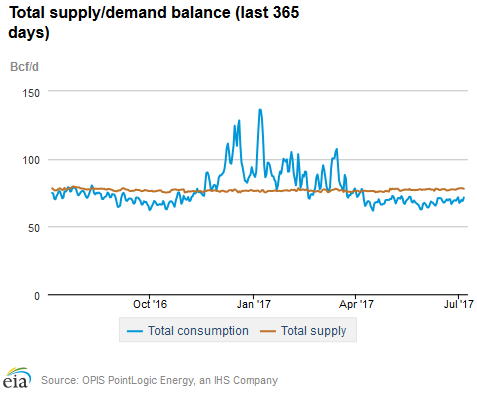
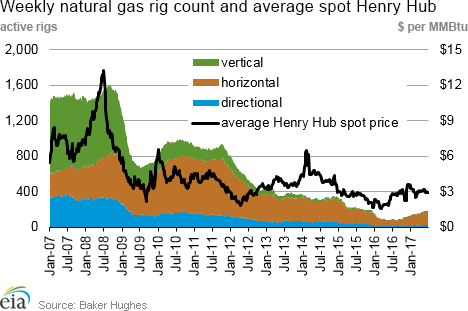
| Rigs | |||
|---|---|---|---|
Fri, June 30, 2017 |
Change from |
||
last week |
last year |
||
| Oil rigs | 756 |
-0.3% |
121.7% |
| Natural gas rigs | 184 |
0.5% |
106.7% |
| Note: Excludes any miscellaneous rigs | |||
| Rig numbers by type | |||
|---|---|---|---|
Fri, June 30, 2017 |
Change from |
||
last week |
last year |
||
| Vertical | 77 |
0.0% |
26.2% |
| Horizontal | 792 |
0.0% |
138.6% |
| Directional | 71 |
-1.4% |
86.8% |
| Source: Baker Hughes Inc. | |||
| Working gas in underground storage | ||||
|---|---|---|---|---|
Stocks billion cubic feet (Bcf) |
||||
| Region | 2017-06-30 |
2017-06-23 |
change |
|
| East | 564 |
536 |
28 |
|
| Midwest | 699 |
676 |
23 |
|
| Mountain | 187 |
184 |
3 |
|
| Pacific | 287 |
280 |
7 |
|
| South Central | 1,151 |
1,140 |
11 |
|
| Total | 2,888 |
2,816 |
72 |
|
| Source: U.S. Energy Information Administration | ||||
| Working gas in underground storage | |||||
|---|---|---|---|---|---|
Historical comparisons |
|||||
Year ago (6/30/16) |
5-year average (2012-2016) |
||||
| Region | Stocks (Bcf) |
% change |
Stocks (Bcf) |
% change |
|
| East | 651 |
-13.4 |
607 |
-7.1 |
|
| Midwest | 761 |
-8.1 |
632 |
10.6 |
|
| Mountain | 201 |
-7.0 |
160 |
16.9 |
|
| Pacific | 313 |
-8.3 |
316 |
-9.2 |
|
| South Central | 1,247 |
-7.7 |
987 |
16.6 |
|
| Total | 3,173 |
-9.0 |
2,701 |
6.9 |
|
| Source: U.S. Energy Information Administration | |||||
| Temperature – heating & cooling degree days (week ending Jun 29) | ||||||||
|---|---|---|---|---|---|---|---|---|
HDD deviation from: |
CDD deviation from: |
|||||||
| Region | HDD Current |
normal |
last year |
CDD Current |
normal |
last year |
||
| New England | 6 |
1 |
1 |
29 |
5 |
8 |
||
| Middle Atlantic | 4 |
2 |
4 |
33 |
-6 |
-14 |
||
| E N Central | 18 |
15 |
16 |
18 |
-26 |
-38 |
||
| W N Central | 19 |
14 |
18 |
28 |
-29 |
-46 |
||
| South Atlantic | 1 |
0 |
1 |
84 |
-2 |
-16 |
||
| E S Central | 2 |
2 |
2 |
64 |
-18 |
-47 |
||
| W S Central | 0 |
0 |
0 |
105 |
-8 |
-25 |
||
| Mountain | 7 |
-6 |
6 |
84 |
18 |
-6 |
||
| Pacific | 1 |
-8 |
-2 |
57 |
26 |
-2 |
||
| United States | 8 |
3 |
6 |
56 |
-5 |
-20 |
||
|
Note: HDD = heating degree day; CDD = cooling degree day Source: National Oceanic and Atmospheric Administration | ||||||||
Average temperature (°F)
7-Day Mean ending Jun 29, 2017
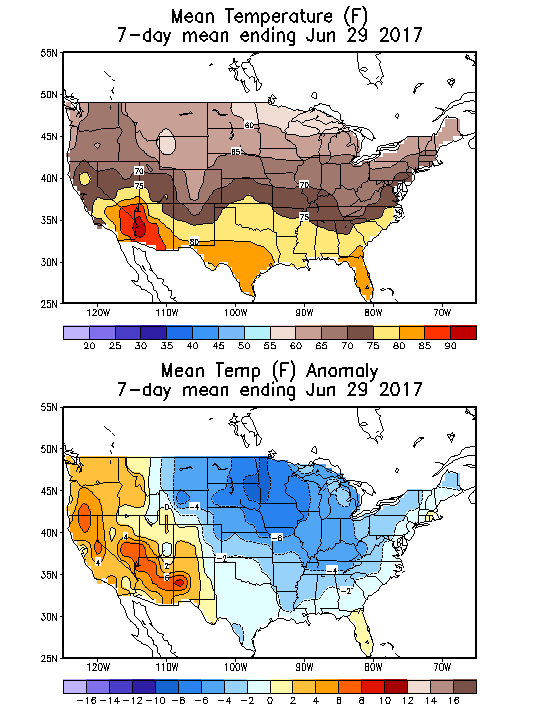
Source: NOAA National Weather Service
Deviation between average and normal (°F)
7-Day Mean ending Jun 29, 2017

Source: NOAA National Weather Service

